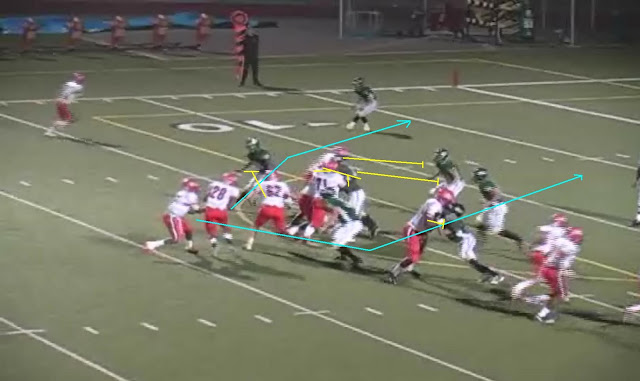The most important thing to remember about the game of football at the high school level is skill development. To that end, we emphasis the following “BIG SIX:”
1) SPLITS
a. G-C 3 FT, G-T 4 FT
b. Inconsistent splits and alignment can destroy the timing of the play and make reacting to defensive movement more difficult
2) STANCE
a. THE MOST FUNDAMENTAL ASPECT OF LINE PLAY
b. Don’t give away a thing; Balance and power on display
3) STARTS
a. WE WIN AND WE LOSE ON THE FIRST TWO STEPS
b. Properly execute the first and second steps as they relate to aiming points, while using the correct shoulder and/or hand placement on all blocks
4) FITS
a. POSITION OURSELVES TO BE SUCCESSFUL EVERY PLAY
b. Proper blocking and power angles for leverage, with correct balance and footwork for control
5) FEET
a. THE KEY TO DOMINATING THE LINE OF SCRIMMAGE
b. Double time (Acceleration) on contact
6) FINISH
a. BE RELENTLESS-LEAVE NO DOUBT
b. Sustain your block to the echo of the whistle.
WE CAN CORRECT POOR TECHNIQUE; WE CAN’T CORRECT POOR EFFORT
Effective offensive linemen in our program have the following characteristics:
1. Attitude:
A good attitude in an offensive lineman can’t be over-emphasized. A player with a good attitude can be taught what he needs to be successful. A player with a bad attitude will have a negative impact on the entire offense. A player has to be selfless before we can develop unity on the offensive line. Once we develop unity we can create an identity. Once we create an identity, then we can establish tradition. It all starts with attitude.
“We work the hardest; we’re known the least. But who cares? For we are the reason.”
2. Effort:
No one should ever question your effort -NEVER! We determine effort by players who go to the echo of the whistle and finish blocks and games. An enthusiastic player will give you great effort.
Be a Hitter: This is why you play! You must relish contact. It's the player who hits first, the hardest, most often and the longest that win Championships. When it comes to being a hitter actions speak louder than words. We want an aggressive player who plays with his head, heart and pads
3. Commitment:
Commitment is fundamental to our success. Ranging from excellence in the class room, to active participation in the community, to even ensuring the pads are brought out everyday to practice, commitment encompasses a wide variety. The following quotes sum up the general philosophy, followed by four areas of emphasis:
“The successful person makes a habit of doing what the failing person doesn't like to do.”
-Thomas Edison, renowned inventor
“Are you here to do something, or are you just looking for something to do?”
-Gordon Elliot, Auburn High School Football Coach
- Loyalty: Playing on the offensive line is about trust and honesty. If trust is ever broken, failure is inevitable. Loyalty is the key to the togetherness needed on the offensive linemen and the team. Loyalty is demonstrated by showing respect for your coaches, yourself, and each other. Loyalty is the key to having “one heart beat” on the offensive line.
- Strength: You can not be ‘allergic to iron’. The key: how it translates onto the field, not just in the weight room. Explosive strength is priority one, with overall strength being next. Strength training helps eliminate injuries, and it allows us to dominate in the tight spaces of the line of scrimmage.
- Conditioning: If you can't breathe, you can't play. It doesn’t get any simpler than that. Fatigue will eventually defeat your opponent, it may also defeat you. Conditioning is an important part of mental toughness. The harder you work the harder it is to surrender.
- Knowledge: There is no excuse for not knowing assignments and how to execute them. Players should also know what all linemen are doing on each play and where the quarterback and running back are going. Knowledge through preparation helps you to think and make a decision under pressure, and to know the assignments of your teammates in order to execute the offense.











